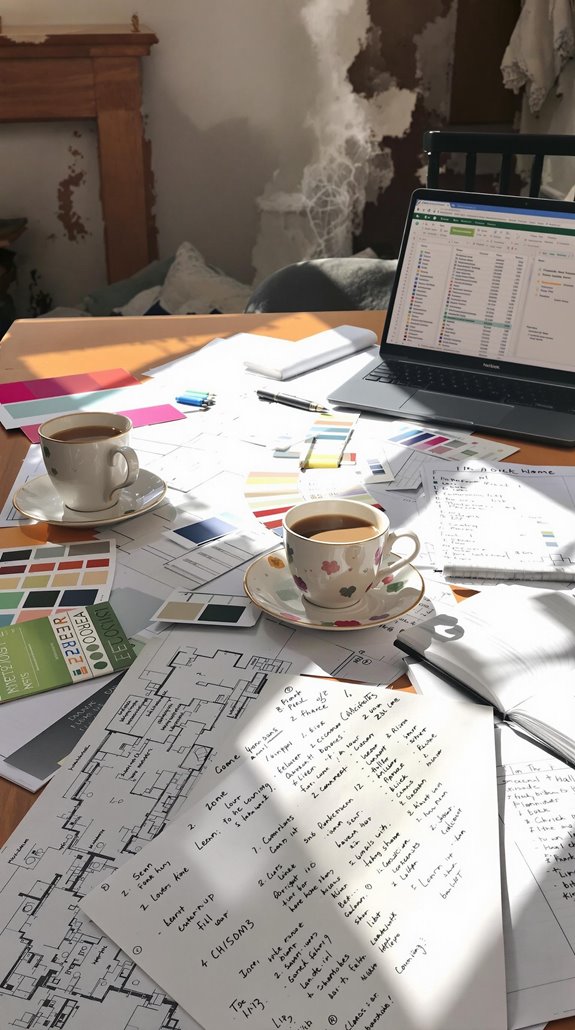I’ve learned that tackling a full house renovation in the UK without breaking the bank requires strategic planning and precise budget allocation. You’ll need specific tools like detailed spreadsheets, contractor comparison matrices, and cost-tracking software to maintain control over your finances. The key lies in understanding how to prioritize structural necessities over cosmetic desires while building in proper contingencies. What most homeowners don’t realize is that the sequence of your renovation phases can make or break your entire budget.
Key Takeaways
- Set clear renovation goals and allocate 60-70% of budget to structural work while maintaining 10-20% contingency fund.
- Obtain three detailed contractor quotes with identical specifications and verify licenses, insurance, and client references.
- Prioritize structural repairs first, then weatherproofing, followed by second-fix elements like ceilings and flooring.
- Reduce labor costs by hiring task-specific contractors and undertaking DIY tasks like demolition and painting.
- Source ex-display and reclaimed materials while consulting local estate agents to identify market-specific renovation priorities.
Setting Clear Goals and Priorities for Your Renovation Project

Why do most renovation projects spiral beyond their intended scope and budget? I’ve found it’s because homeowners skip the vital step of defining clear, measurable objectives before they start swinging hammers.
Here’s my systematic approach: First, I categorize each room’s needs into essential structural work versus aesthetic upgrades. I allocate 60-70% of my budget to structural integrity—roof repairs, damp proofing, electrical rewiring—before considering cosmetic improvements. Understanding the potential costs of home extension expenses can also help homeowners plan more effectively.
I use a scoring matrix to separate “must-haves” from “nice-to-haves,” ranking rooms by usage frequency. Kitchen and bathroom renovations get priority since they deliver 15-20% property value increases. I document every goal with specific metrics like “increase energy efficiency by 30%” and cap project phases to prevent scope creep. I always include a contingency fund of 10-20% to cover unexpected expenses that inevitably arise during renovation work. This methodical planning keeps me focused and prevents costly mid-project changes.
Researching Average Renovation Costs Across the UK
With clear goals established, I now need hard data to build a realistic budget framework. Two-bedroom house renovations typically cost £107,900 to £147,300, while three-bedroom properties range from £43,530 to £110,350. Full home renovations average £45,000 to £76,500, with extensive projects spanning £15,000 to £85,000.
Breaking down components: loft conversions average £50,000, kitchens cost £12,500 to £30,000, bathrooms around £6,000, windows £5,000, and rewiring £6,500. Per square metre, I’m looking at £700 to £2,000, depending on location and specifications. Understanding regional price variations can help better inform my budget.
I’ll add a 10-15% contingency for unexpected costs like structural issues or material price surges. Hidden expenses often include rot repair (£1,500), woodworm treatment (£400-£800), and gas installation (£1,500). Consulting with professional estimators who are Chartered Members (MRICS) and Members of the Chartered Institute of Building (MCIOB) provides the most accurate cost assessments for unique renovation projects. This data forms my budget foundation.
Obtaining and Comparing Multiple Contractor Quotes
Before I commit to any contractor, I’ll gather at least three detailed quotes to establish competitive pricing and identify the best value proposition. I’ll define my project scope precisely, providing identical specifications to each contractor during simultaneous site visits. This guarantees consistent understanding and comparable bids.
I’ll verify each contractor’s licenses, insurance coverage, and request three client references. Their portfolios should demonstrate comparable project complexity to mine. I’ll demand itemized breakdowns covering labor, materials, and project phases, specifying exact material grades to prevent quality discrepancies. Additionally, it’s important to consider that cost-effective renovations can significantly impact the overall project budget.
When analyzing price variations, I’ll scrutinize material quality differences and warranty coverage. I’ll use standardized spreadsheets to reconcile bids, tracking inclusions and exclusions. I’ll prioritize lifecycle costs over initial pricing, making certain contract clauses cover change-order procedures and dispute resolution before signing. I’ll assess each contractor’s communication style to ensure clarity and openness throughout the project, as this indicates their ability to maintain transparency during the renovation process.
Creating a Realistic Contingency Budget for Unexpected Expenses
Since renovation projects inevitably encounter unforeseen complications, I’ll establish a dedicated contingency fund that’s separate from my primary budget allocation. I’ll set aside 10-20% of my total renovation budget, adjusting higher for older properties where structural surprises lurk behind walls. My contingency targets common unexpected costs: rotting beams, asbestos remediation, electrical system overhauls, and building regulation compliance updates. Understanding the importance of mortgage valuation surveys can also help identify potential issues that could affect funding.
I’ll track contingency spending through a dedicated spreadsheet, requiring written approval before accessing funds. Critical structural and safety issues take priority over aesthetic upgrades. To minimize unexpected costs, I’ll invest in thorough pre-renovation surveys and exploratory openings that reveal hidden problems before finalizing plans.
I’ll consider financing options if my budget’s limited, ensuring I’m prepared for renovation’s inevitable surprises without derailing my project. When working with contractors, I’ll maintain clear communication throughout the renovation process to prevent cost overruns and ensure any additional expenses are discussed before proceeding.
Prioritizing Renovation Phases Based on Urgency and Impact

When tackling a house renovation, I’ll approach it systematically by categorizing work phases according to their urgency and potential impact on the project’s success. I’ll prioritize structural repairs first – foundations, damp-proofing, and load-bearing walls can’t wait. Next, I’ll secure the building envelope through re-plastering and weatherproofing before tackling first-fix services like plumbing and electrics. This prevents costly rework later.
I’ll sequence second-fix elements strategically: ceilings before floor finishes, then tiling in wet areas. Fixtures and fittings come next, followed by decoration as the final phase. This approach minimizes trade conflicts and protects completed work. I’ll also consider seasonal factors – roofing during dry months, internal work during winter. Before beginning any phase, I’ll gather multiple estimates from local contractors to establish accurate cost baselines for each stage of work. Each phase builds upon the previous, creating a logical progression that maximizes efficiency while controlling costs. Moreover, investing in a house extension can further enhance both space and value in the long term.
Finding Cost-Effective Alternatives Without Compromising Quality
While maintaining quality standards, I’ll leverage strategic material substitutions and smart sourcing to maximize my renovation budget’s impact.
I’ll focus on mid-range, locally sourced materials that balance durability with cost-effectiveness. Comparing supplier quotes enables bulk discounts on high-volume items like flooring and tiles. Reclaimed timber from salvage yards delivers unique character at a fraction of new material costs. Additionally, converting a garage into living space can provide a valuable return on investment, enhancing overall home functionality.
Standard-size fittings eliminate custom fabrication fees for windows and cabinets. I’ll substitute expensive finishes with quality alternatives—luxury vinyl planks instead of hardwood in low-traffic areas, or laminate countertops mimicking natural stone. A detailed expense tracking spreadsheet with formulas ensures I monitor all costs effectively throughout the renovation process.
For labor optimization, I’ll hire task-specific contractors rather than premium all-trades services. Prefabricated components like modular kitchens reduce installation time and waste. I’ll repurpose existing structural elements where possible, avoiding costly alterations while maintaining the renovation’s integrity and functionality.
Managing Your Budget Throughout the Renovation Process
After establishing my renovation budget and sourcing cost-effective materials, I’ll implement systematic tracking mechanisms to prevent overruns and maintain financial control throughout the project. I’ll maintain a detailed spreadsheet updated daily with categorized expenses, comparing actual spending against forecasts weekly to catch overruns early. Digital budgeting apps provide automatic expense logging and alerts that keep me accountable. Additionally, utilizing tools like an Extension Cost Calculator can help refine my budget by providing detailed insights into potential expenses.
I’ll establish a contingency fund of 10-15% for genuine unforeseen expenses, documenting every expenditure for transparency. My renovation sequence prioritizes structural work first, deferring cosmetic updates until essential tasks are completed within budget. I’ll enforce strict change order protocols, requiring written approval and limiting non-essential changes to 5% of my initial budget. Weekly contractor meetings guarantee we’re aligned on progress and costs. When selecting contractors, I’ll obtain multiple quotes from reputable professionals to ensure competitive pricing and quality workmanship.
Maximizing Value While Staying Within Financial Constraints
Since maximizing renovation value requires strategic decision-making at every stage, I’ll implement a value-engineering approach that weighs each expenditure against its potential return on investment. I’ll prioritize high-impact renovations like kitchen updates and garden improvements that align with current buyer trends, while consulting local estate agents to identify market-specific demands. Adding a home extension can also significantly boost property value and enhance living space, making it an attractive option for potential buyers.
I’ll source ex-display and reclaimed materials to achieve 20-50% savings on retail prices, negotiate bulk discounts, and use competitive bidding for professional services. By undertaking DIY tasks like demolition and painting where my skills permit, I’ll reduce labor costs by 30-50%. I’ll maintain detailed budget breakdown throughout the project to track all expenses meticulously and ensure funds last through completion. I’ll invest strategically in energy efficiency upgrades that deliver long-term utility savings exceeding 10%, ensuring each pound spent contributes to both immediate functionality and future resale value.
Conclusion
I’ve outlined the technical framework for executing your budget renovation: structured goal-setting, thorough cost analysis, multi-quote procurement, and contingency planning. You’ll need spreadsheet tracking tools, contractor verification systems, and phase-based scheduling to maintain control. Don’t skip the 10-20% contingency buffer—it’s your safety net. Stick to your priority matrix, leverage DIY where practical, and monitor expenses weekly. With these systematic approaches, you’ll deliver your renovation on budget while maintaining quality standards.
References
- https://www.checkatrade.com/blog/cost-guides/cost-renovating-house/
- https://sheararchitecturaldesign.co.uk/budgeting-for-your-home-renovation-tips-to-keep-costs-in-check/
- https://www.hillarys.co.uk/static/home-renovation-statistics/
- https://ukconstructionblog.co.uk/2024/10/15/how-to-create-a-budget-for-your-home-renovation/
- https://hoa.org.uk/advice/guides-for-homeowners/i-am-buying/house-renovation-costs/
- https://crestprojects.co.uk/house-renovation-ultimate-checklist-smooth-project/
- https://www.checkatrade.com/blog/expert-advice/house-renovation-checklist/
- https://fifimcgee.co.uk/blog/step-by-step-renovating-a-house-where-to-start
- https://www.build-review.com/uk-house-renovation-budget-guide/
- https://smlconstructionltd.com/news/planning-home-renovation-costs-budgeting-guide/

